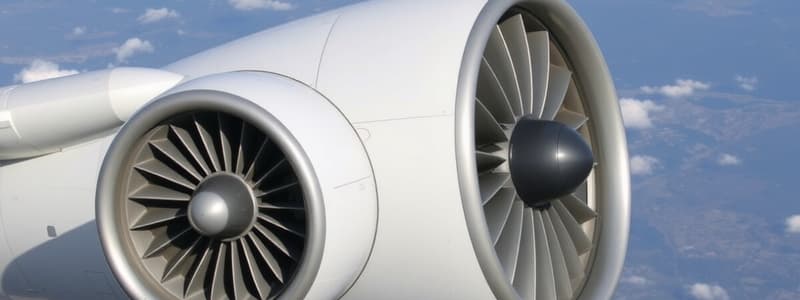Podcast
Questions and Answers
Which of the following indicates a compressor stall has potentially occurred?
Which of the following indicates a compressor stall has potentially occurred?
- Stable engine noise
- Decreasing N1 and torque (correct)
- Increase in airspeed
- Reduction in engine temperature
What is the first step to take when encountering an inadvertent departure from controlled flight?
What is the first step to take when encountering an inadvertent departure from controlled flight?
- PCL - IDLE (correct)
- Power setting to maximum
- Check for atmospheric conditions
- Activate emergency landing pattern
In the event of a compressor stall, which audible indication may be present?
In the event of a compressor stall, which audible indication may be present?
- Consistent engine sound
- Smooth engine operation
- Loud bangs or backfires (correct)
- Low fuel warning
What may happen if control inputs are excessive near a stall condition?
What may happen if control inputs are excessive near a stall condition?
What is a critical action to take during a forced landing after powering down?
What is a critical action to take during a forced landing after powering down?
What is the initial action recommended when experiencing a compressor stall?
What is the initial action recommended when experiencing a compressor stall?
Which procedure should be avoided to ensure proper recovery from an unusual attitude?
Which procedure should be avoided to ensure proper recovery from an unusual attitude?
What is the effect of improperly positioning the control stick/elevator during an engine failure?
What is the effect of improperly positioning the control stick/elevator during an engine failure?
In the event of a fire warning light without accompanying indications, what is the correct procedure?
In the event of a fire warning light without accompanying indications, what is the correct procedure?
What altitude is recommended as a minimum for ejection to ensure crew safety?
What altitude is recommended as a minimum for ejection to ensure crew safety?
Study Notes
Compressor Stalls
- Compressor stalls can arise from damaged blades, disrupted airflow, or malfunctioning bleed valves.
- Occur during engine acceleration or deceleration; severe cases may lead to engine damage or flameout.
- Initial signs include abnormal engine noise, increasing ITT, decreasing N1, and fluctuations in torque.
- Audible symptoms may consist of loud bangs, backfires, or engine sputtering, assisting in diagnosing the malfunction.
Recovery Procedures
- For a compressor stall, follow these steps:
- Gradually retard PCL below stall threshold.
- Set DEFOG switch to ON to increase bleed air inflow and reduce back pressure on the engine.
- Check altitude; a minimum of 6000 feet AGL is recommended for ejection.
- Recover from unusual attitudes to avoid loss of aircraft and crew.
Engine Fire Procedure
- A fire warning light without confirmed fire does not necessitate engine shutdown.
- Glide performance may be significantly reduced after an unusual flight attitude.
Inadvertent Departure from Controlled Flight
- Can occur from improper control inputs, mechanical failures, or atmospheric conditions.
- Power settings greatly influence recovery; reducing power may enable recovery without further action.
- In case of an inadvertent departure:
- Bring PCL to IDLE immediately.
- Adjust PCL as required after N1 stabilizes at approximately 67% N1.
Airstart Procedure
- Initiate the immediate airstart (PMU NORM) after an engine failure at low altitude when quick thrust is needed.
- Follow these steps in the event of a suspected mechanical failure during airstart attempts:
- Turn the starter switch to NORM and verify generator status.
- If N1 does not rise in 5 seconds, cease the attempt and proceed as directed for unsuccessful airstarts.
Operational Notes
- Maintain boost pump in the ON position for engine-driven fuel pump operation.
- Expect high amperage readings after start; monitor these to ensure generator functionality.
- The starter left in MANUAL mode will deplete battery power in 10 minutes.
Studying That Suits You
Use AI to generate personalized quizzes and flashcards to suit your learning preferences.
Related Documents
Description
This quiz explores the critical issues related to aircraft controls, focusing on the effects of improper control stick positioning and the causes of compressor stalls. Understanding these factors is essential for safe aircraft operations. Test your knowledge on preventing engine damage and flameouts through proper control techniques.




